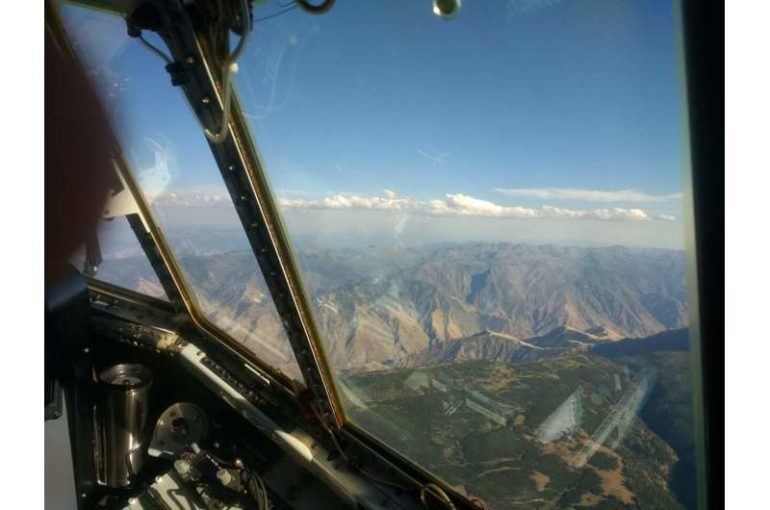As wildfires and heatwaves stress the western United States, concern over drought is rising: Dry landscapes burn more readily, and rain can help quell fires already raging. But wildfire smoke may keep that essential rain from falling.
A new study finds tiny particles in wildfire smoke affect the way droplets form in clouds, potentially resulting in less rain and exacerbating dry conditions that fuel fires.
When wildfires send smoke up into the atmosphere, tiny particles fly up with it. Water droplets can condense on the particles in clouds.
The study’s authors expected an increase in the number of water droplets forming in clouds as a result of wildfires, because more particles create more droplets. But the difference between smoky and clean clouds was bigger than expected, with smoky clouds hosting about five times the number of droplets than their clean counterparts. Smoky droplets were also half the size of pristine droplets.
That size difference is what could stop the drops from falling. Because small droplets are less likely to grow and eventually fall out as rain, wildfires in the western U.S. could mean less rain during wildfire season, according to the new study published in the AGU journal Geophysical Research Letters, which publishes high-impact, short-format reports with immediate implications spanning all Earth and space sciences.
“We were surprised at how effective these primarily organic particles were at forming cloud droplets and what large impacts they had on the microphysics of the clouds,” said lead author Cynthia Twohy, an atmospheric scientist at NorthWest Research Associates and Scripps Institution of Oceanography. “I started thinking, ‘What are the long-term effects of this? We have drought, and we have a lot of wildfires, and they’re increasing over time. How do clouds play into this picture?'”
Twohy and a team of atmospheric chemists spent the summer of 2018 in a C-130 Hercules research plane, sampling mid-altitude altocumulus clouds while fires burned across the western U.S. Instruments on board the plane measured gases and particles emitted by wildfires and sampled droplets, whose chemistry Twohy analyzed back in the lab.
The work provides direct new insight into the microphysics and chemistry of wildfire-linked clouds that can help scientists understand potential causes and effects of atmospheric changes during wildfires.
Smoky cloud complexities
In clouds that reach high into the atmosphere, adding more particles can invigorate the clouds and cause rain, but the opposite is true for lower-altitude cumulus clouds like those Twohy studied. Previous work, unrelated to the present study, found similar changes in droplet size and concentration related to smoke in the Amazon, supporting the new findings.
“What really excited me about this paper were the connections to the hydrological cycle,” said Ann Marie Carlton, an atmospheric chemist at the University of California-Irvine who was not involved in the new study. “They observe differences in cloud droplet size and precipitation, and cloud formation definitely impacts the hydrologic cycle. To have cloud-related findings so robust is sort of unusual, in my experience.”
Cloud microphysics are complex, and Twohy notes that there are factors other than droplet size to consider for the overall impact smoky clouds have on regional climate. The new study focused on small cumulus clouds, which blanket about a quarter of the western U.S. in the summer, but other types of clouds, like higher-altitude thunderstorms, could behave differently. In shallower clouds, the more numerous, smaller droplets also can be more reflective, which could have a slight cooling effect at the surface.
With summer rain in the region decreasing, Twohy thinks the drying effects are winning out over factors that could increase rain, like cloud invigoration.
“Over the past couple decades, summer precipitation is down and temperatures are up. The cloud effects are likely an important part of all this. I’m hoping these results will spur detailed regional modeling studies that will help us understand the net impact of smoke on clouds and climate in the region,” said Twohy.
If wildfire smoke is making rain less likely, feedback between smoke, dry spells and more wildfires could be more common in the future. Cloud microphysics are complex, so it may be a matter of time before these relationships are clear. Regardless, in connecting wildfire smoke to cloud changes and tentatively, precipitation, Twohy’s new research pushes atmospheric physics and chemistry to catch up with climate change.
“As humans have perturbed the composition of the atmosphere, there are all these feedbacks and interactions that we don’t even know about,” said Carlton. “This experiment we’re doing on planet Earth is altering clouds and the hydrologic cycle, at least regionally. I think this paper is scratching the surface of what we don’t know.”
Seeding ice clouds with wildfire emissions
More information:
Cynthia H. Twohy et al, Biomass Burning Smoke and Its Influence on Clouds Over the Western U. S., Geophysical Research Letters (2021). DOI: 10.1029/2021GL094224
Provided by
American Geophysical Union
Citation:
Wildfire smoke may lead to less rain in the western US (2021, August 11)
retrieved 11 August 2021
from https://phys.org/news/2021-08-wildfire-western.html
This document is subject to copyright. Apart from any fair dealing for the purpose of private study or research, no
part may be reproduced without the written permission. The content is provided for information purposes only.
